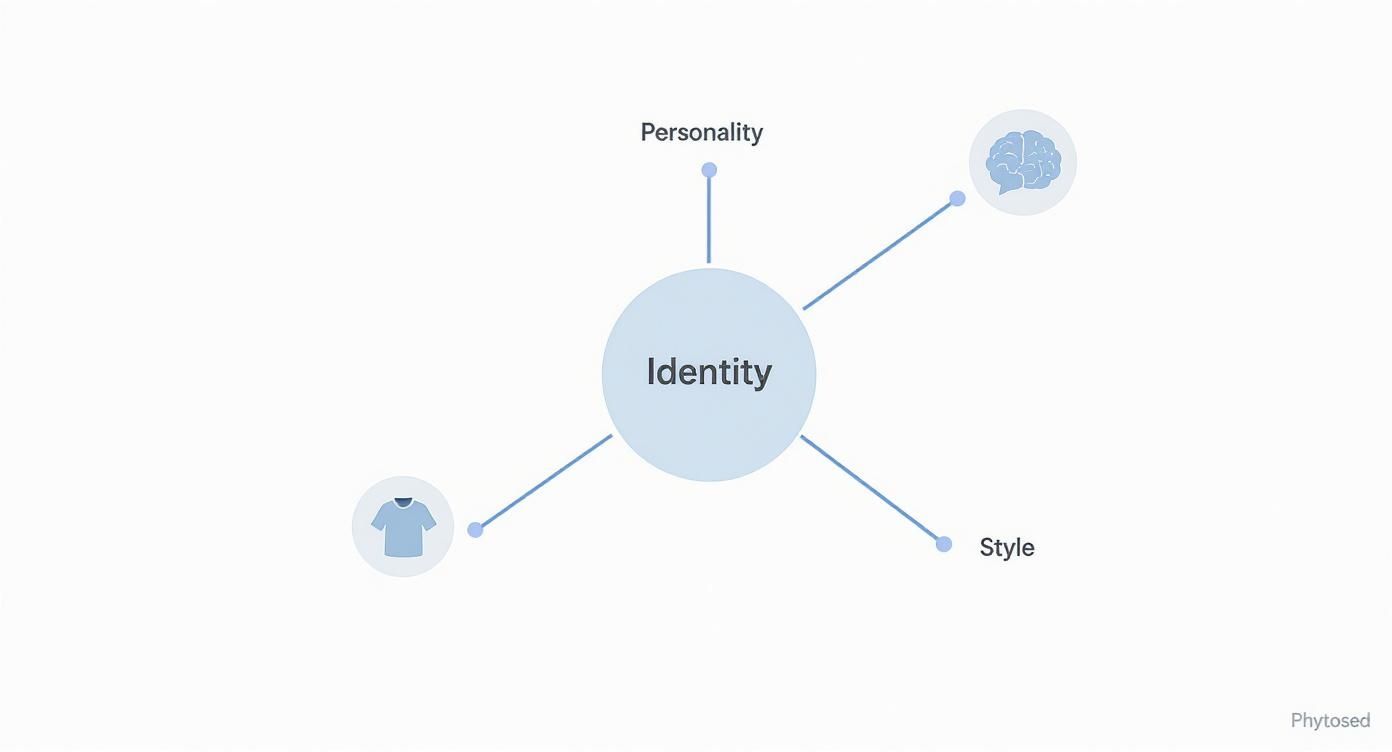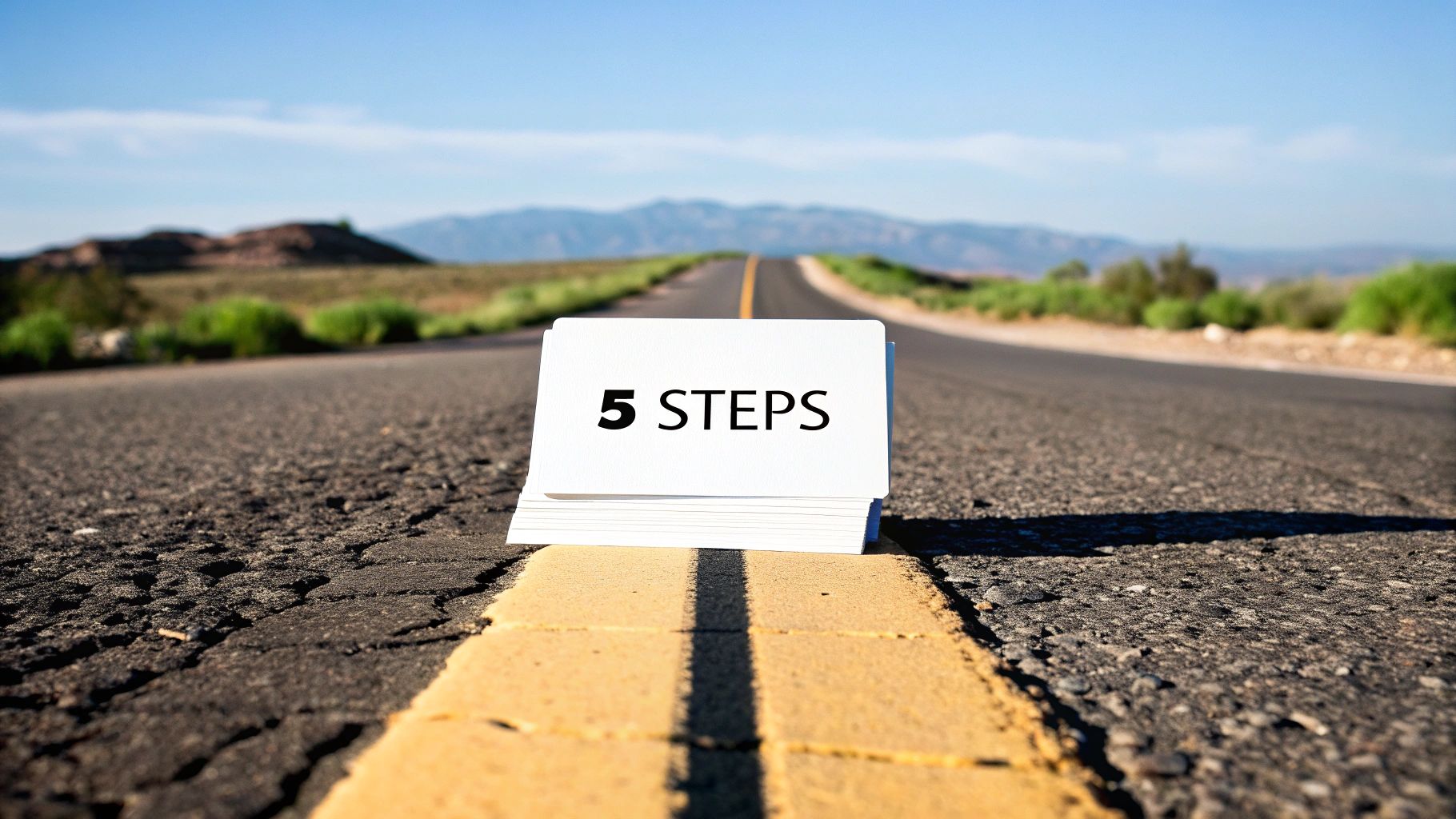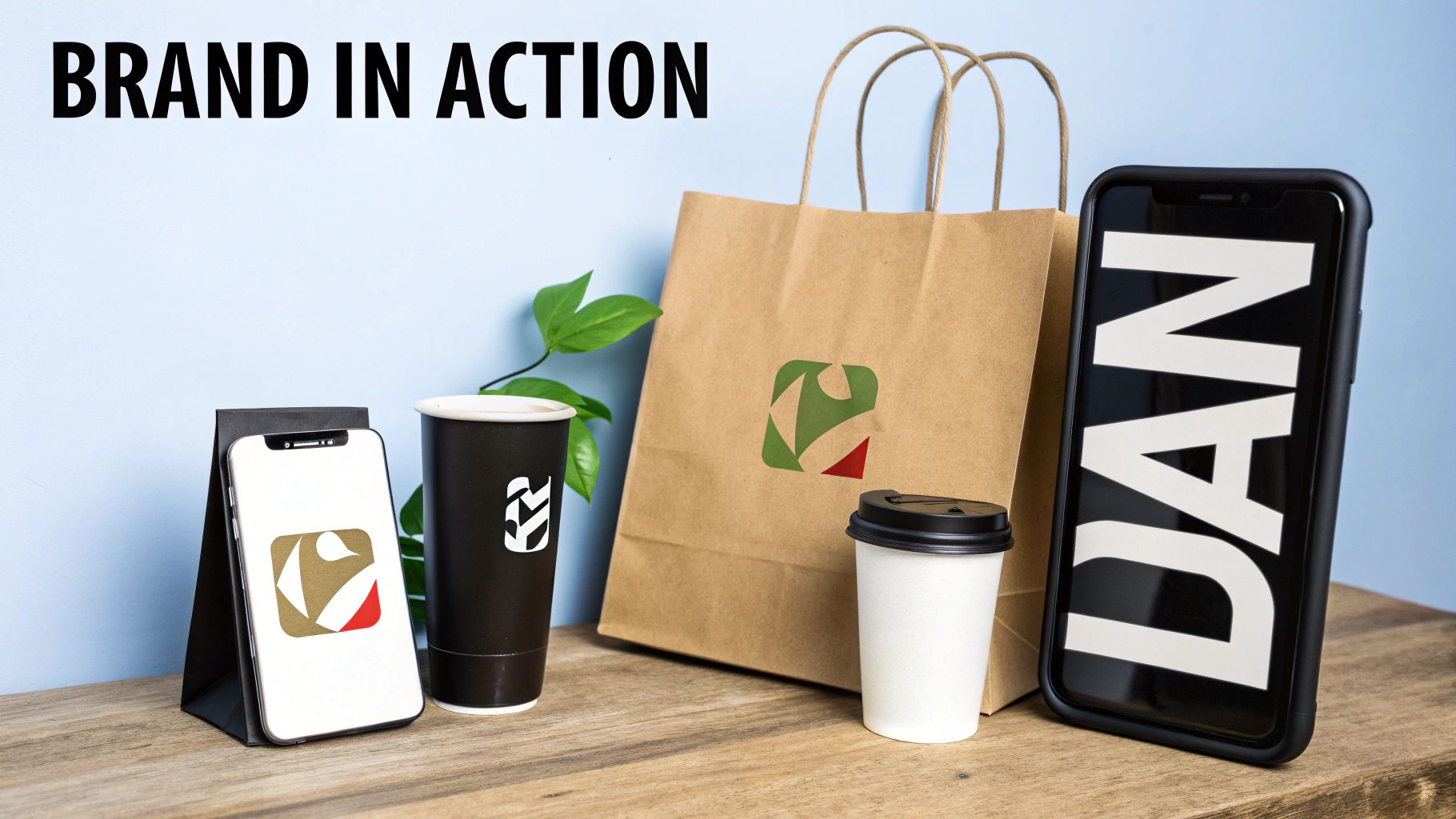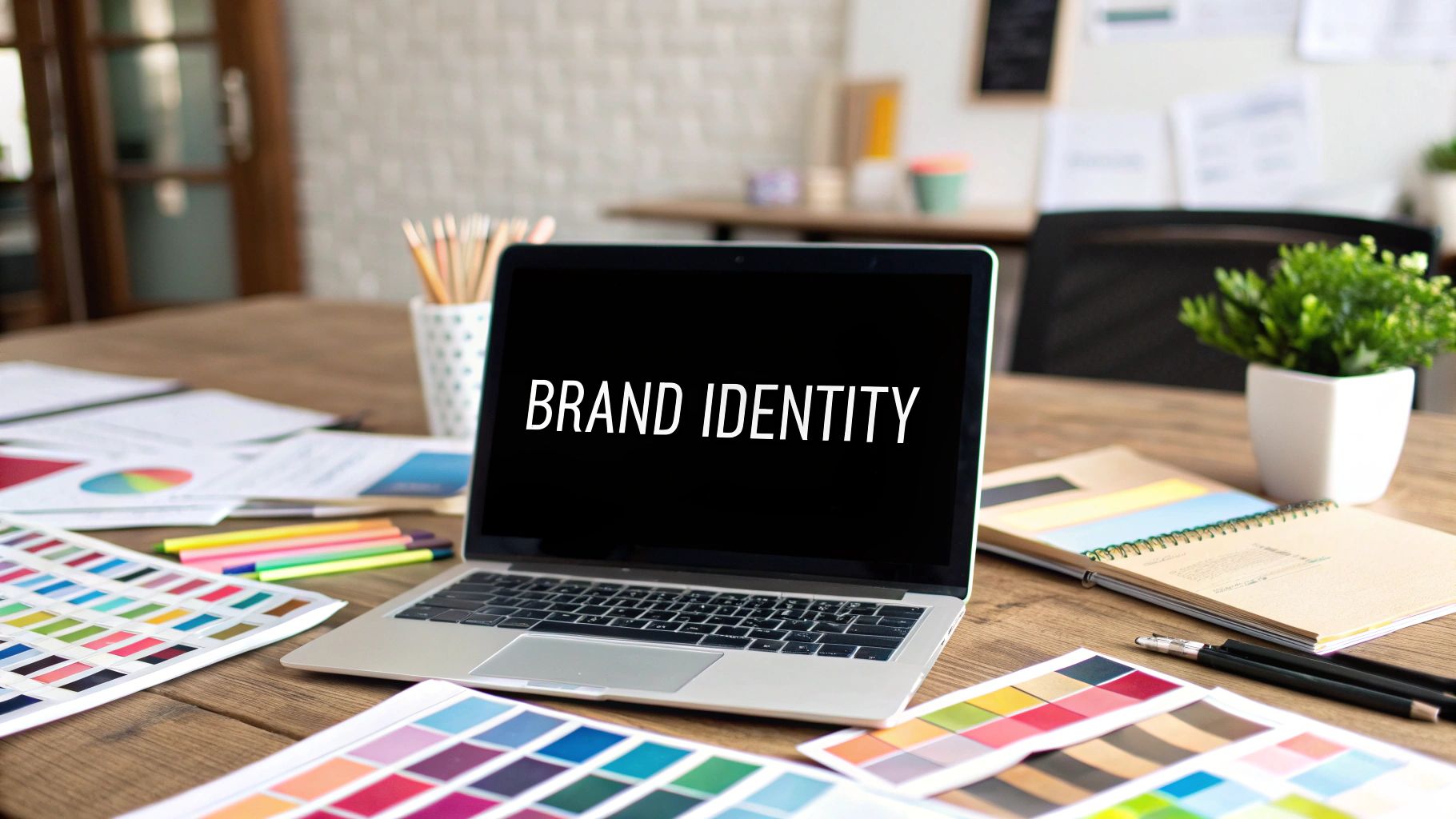Brand identity design is how you intentionally shape the way your business looks, feels, and communicates. It's the process of creating all the tangible, sensory pieces that represent your company’s core values and personality. Think of it as the complete visual and verbal system that makes you instantly recognizable.
It’s a common misconception that this just means designing a logo. In reality, a logo is just one piece of a much larger puzzle.
Making Your Brand's Personality Tangible
Imagine your business is a person. What’s their style? How do they talk? What kind of feeling do they leave you with after a conversation? That's the essence of brand identity design. It’s the deliberate act of translating your company's abstract character into concrete visual and verbal cues that people can connect with.
This system is a strategic blueprint that guides everything you create. It defines the exact color palette for your website, the fonts used in your marketing emails, and even the tone of voice in your social media updates. Every single element is chosen to work together, sending a clear, consistent message about who you are. This collection of assets is what sets you apart from the competition and starts building real trust with your audience.
It's More Than Just a Good First Impression
We all know first impressions matter, but you might be surprised by how quickly they happen. It takes a potential customer just 0.05 seconds to form an opinion about your brand based on what they see. A massive part of that snap judgment comes down to your visuals. This is precisely why a strong identity isn't a "nice-to-have"—it's an absolute necessity for making an immediate, positive connection. You can find more fascinating stats on how consumers perceive brands in this detailed branding statistics report.
A well-crafted identity ensures that every time someone interacts with your brand, the experience is consistent and reinforces your message. The goal is to build a sense of familiarity and reliability that fosters recognition and, eventually, deep-seated loyalty.
Brand identity is the tangible expression of your brand’s personality. It’s what customers see, touch, and hear, transforming abstract ideas like 'trustworthy' or 'innovative' into a concrete reality.
At the end of the day, this whole system is built on the foundation of your brand's unique character. It brings your story to life, making your business not just another company in the crowd, but a memorable and distinct presence. To really get to the bottom of this, check out our guide on what is brand personality and how it boosts your impact.
The Building Blocks of a Memorable Brand
A powerful brand identity isn't just one thing. It's a whole system of parts, all working together to tell a single, clear story. To really get what brand identity design is, you have to look at its core components. These are the tangible pieces you’ll use to shape how the world sees, feels, and remembers your business.
Each element has a job to do, whether it’s catching someone's eye or quietly communicating your company’s values. When they all click into place, they create an experience that feels authentic and sticks in people's minds. Let's break down the essential elements that build this foundation.
This visual map helps show how different pieces—like style, voice, and personality—all connect back to the central idea of your brand's identity.

As you can see, a strong identity is truly the sum of its parts. It requires a thoughtful approach to both what people see and what they hear from you.
Your Logo: The Face of Your Brand
Your logo is usually the first thing that comes to mind when people think of your business. It’s the visual handshake, the anchor for your entire identity. A great logo is a simple, memorable mark that shows up everywhere, from your website to your product packaging. But it's far more than a pretty picture; it's a strategic tool designed for instant recognition.
And that impact is huge. Think about it: 75% of consumers can identify a brand just by its logo. What's more, when that logo is used consistently across the board, it's tied to a 23% increase in revenue. That’s proof that a solid visual symbol isn't just about looking good—it directly impacts your bottom line.
Color Palette and Typography
Beyond the logo, color and typography are the real workhorses of your visual identity. These are the elements that set the mood and convey your brand's personality in an instant.
- Color Palette: Colors are shortcuts to emotion. A splash of blue can signal trust and stability, while a bright yellow might feel optimistic and full of energy. A well-chosen color palette ensures every touchpoint feels like you and helps people remember you.
- Typography: The fonts you pick say a lot. A clean, modern sans-serif font can suggest innovation and simplicity, while a classic serif font might project a sense of tradition and authority.
These aren't just decorative choices. They're psychological cues that start shaping perception before a customer ever reads a single word of your copy.
Imagery and Brand Voice
While the visuals get a lot of attention, your brand’s voice and the imagery you select are just as vital for creating a complete picture.
A brand's voice is the consistent personality and tone you use everywhere you communicate. It’s not just what you say, but how you say it—whether you're friendly and casual, formal and authoritative, or witty and playful.
Imagery—like your photography, illustrations, and icons—is what brings your brand to life. It needs to feel like it belongs with your logo, colors, and voice to create a seamless experience. Together, these visual and verbal elements become some of the most important brand assets you’ll ever create. For a deeper look, check out our guide on what are brand assets and how they build business value.
Once you've nailed down these core elements, the next step is crucial: document everything. This ensures everyone on your team—and any future partners—uses these building blocks correctly and consistently. Learning how to create effective brand guidelines is essential for keeping your identity strong as you grow. It’s what turns your great design ideas into a practical, everyday system for your whole company.
Why a Strong Brand Identity Drives Growth
So, we know what brand identity is made of. But why pour time and resources into getting it right? Simple: a cohesive identity is one of the most powerful tools you have for growing your business. It's not just about looking good—it's a strategic asset that builds recognition, inspires loyalty, and creates real, tangible value.
Think of it this way. In a crowded marketplace, your brand identity is your beacon. It’s what helps customers find you, remember you, and choose you over a dozen other options. That immediate recognition is the starting point for everything else.
Building Trust Through Consistency
Consistency is the bedrock of trust. When your visuals and your voice are the same everywhere—on your website, in your emails, across social media—you create a reliable and predictable experience. Customers see you as professional and dependable, which is essential for earning their business.
This isn't just a gut feeling; the numbers back it up. By 2025, an estimated 81% of consumers will need to trust a brand before they even think about buying, and 77% already prefer purchasing from brands they follow online. A consistent identity makes sure your story is clear and trustworthy, no matter where people find you. You can find more stats like this in a great branding report from Exploding Topics.
This steady, consistent presentation of who you are and what you stand for is how you start to build genuine brand equity. To go deeper on that, check out our guide on what is brand equity and how to boost your brand.
Creating Differentiation and Competitive Advantage
In a sea of similar products and services, a unique brand identity is your lifeline. It's your chance to carve out a specific space in a customer's mind, showing them exactly what makes you different—and better—than everyone else.
A memorable brand identity transforms your business from a commodity into a distinct choice. It moves the conversation from "what does it cost?" to "what does it represent?"
This differentiation helps you connect with people on an emotional level, moving beyond a simple list of features. When customers align with your brand's personality and values, they stop being just customers. They become fans.
Commanding Premium Pricing and Loyalty
A strong, professional brand identity projects quality and value. Businesses that feel more credible and established can often charge more for what they offer, because people are willing to pay a premium for a brand they trust and feel a connection to.
That connection is also the key to long-term loyalty. When your identity consistently delivers on its promise, customers have a reason to stick around. They aren't just buying a product; they're buying into the story and the experience your brand represents. This creates a loyal base that isn’t easily swayed by competitor discounts, securing a more stable and profitable future for your business.
The 5 Steps to Building Your Brand Identity

Creating a brand identity from scratch can feel like a massive undertaking. The good news? It's not magic. It's a process. By breaking it down into a clear roadmap, you can move from a rough idea to a fully-formed brand that’s ready to connect with people.
Think of it as building a house. You wouldn't start throwing up walls without a blueprint. Each step here lays the foundation for the next, making sure your final identity isn't just pretty, but is built on a solid understanding of your business and your customers. Let's walk through the five essential steps.
1. Conduct Deep Discovery and Research
Before you even think about a logo or a color palette, you have to do your homework. This first step is all about listening and learning—looking outward at the market and inward at your own company. It's the most critical part of the entire process.
Your goal is to become an expert on the world your brand will exist in. You'll want to dig into three key areas:
- Your Target Audience: Who, really, are you talking to? Forget basic demographics. What do they value? What keeps them up at night? What are they trying to achieve?
- Your Competition: Size up the other players in your space. Look at their brand identities. What’s working for them? More importantly, where are the gaps? What aren't they saying that you can?
- Your Unique Position: Get crystal clear on what makes you different. What is your mission? What are your core values? What do you bring to the table that nobody else does?
This research isn't just busy work; it saves you from designing in a vacuum and ensures your brand is relevant and distinct from day one.
2. Craft Your Brand Strategy
Okay, you've gathered your intel. Now it's time to turn that research into a game plan. This is where you build your brand’s personality and define how it will communicate. Your brand strategy is the compass that will guide every single decision you make from here on out.
A simple way to think about it is to imagine your brand as a person. What's their personality like—are they a wise mentor, a playful friend, or a trusted expert? How do they talk? Answering these questions helps you nail down your core messaging and your tone of voice.
Your brand strategy is the blueprint for your identity. It answers the fundamental questions: Who are you? Who are you for? And why should anyone care?
A strong strategy is what makes sure every piece of your brand—from a social media post to your packaging—tells the same, compelling story.
3. Design Your Visual Identity
Here we go—this is the part everyone gets excited about. It's time to take the strategy you just built and make it visible. You'll now develop the tangible, visual assets that will represent your brand out in the real world.
This is where your brand's personality gets a face. The key elements you'll be creating include:
- Logo: This is the anchor of your visual identity. It needs to be simple, memorable, and work everywhere from a billboard to a tiny app icon.
- Color Palette: Colors are a shortcut to emotion. You'll choose a set of primary and secondary colors that evoke the right feeling for your brand.
- Typography: The fonts you use are your brand's voice in written form. Your typography should reflect the personality you defined in your strategy.
- Imagery: What's your style for photos, illustrations, and icons? Creating a consistent visual language helps bring your brand to life.
Remember, every visual choice should tie directly back to your strategy. That’s how you create an identity that’s not just beautiful, but meaningful.
4. Create Your Brand Style Guide
You’ve designed a fantastic set of visual assets. Now, how do you keep them from going off the rails? You create a rulebook. A brand style guide is a document that clearly explains how every part of your brand should be used.
This guide is your single source of truth, ensuring that everyone who touches your brand—employees, freelancers, agencies—uses it correctly and consistently. A big part of this is knowing how to create brand guidelines that are simple enough for anyone to understand and follow.
Your style guide should include clear instructions on logo usage (and misuse!), color codes, font hierarchies, and tone of voice. It's the essential tool for maintaining a strong brand over time.
5. Implement Your Identity Everywhere
The final step is to put your new identity to work. It’s time for the rollout. Consistency is everything when it comes to building brand recognition and trust, so this launch needs to be thorough.
Apply your new visual identity across every single touchpoint where a customer might interact with you. We’re talking about your website, social media profiles, email newsletters, business cards, product packaging, and in-store signage.
This is where all your hard work pays off, as people finally get to see and experience your cohesive, professional brand in its entirety.
How Winning Brands Bring Their Identity to Life

It’s one thing to talk about brand identity in theory, but the real lightbulb moments happen when you see it in action. The best brands don’t just have a nice logo. They build an entire world where every color, word, and interaction works in harmony to tell one clear, compelling story.
These companies masterfully turn abstract ideas like "efficiency" or "calm" into something you can actually feel and experience. By looking at how they pull it off, you can see how every single building block—from the logo right down to the tone of voice—serves a very specific purpose.
Let’s dig into a couple of great examples to see how their design choices are a direct line to their mission and their audience.
Slack: Making Work Feel Less Like Work
Slack's mission is to make our working lives simpler, more pleasant, and more productive. Their brand identity is a masterclass in achieving this by side-stepping the cold, corporate vibe we’ve come to expect from business software. Instead, they built an identity that feels human, energetic, and genuinely friendly.
You can see this strategy woven into every detail:
- Color Palette: Slack uses a bright, varied color scheme anchored by a distinctive purple. The colors feel collaborative and full of life—a world away from the dull blues and grays of old-school office tools.
- Logo: Their logo, an octothorpe (or hashtag symbol), is made of simple shapes that look like speech bubbles coming together. It’s a brilliant visual metaphor for communication and teamwork.
- Brand Voice: The tone is always helpful, approachable, and even a little quirky. From the messages you see while it’s loading to their release notes, the language sounds like it’s coming from a friendly coworker, not a faceless program.
Every choice reinforces the idea that work doesn't have to be a drag. It makes the platform feel less like a tool you have to use and more like the place your team comes together.
A brand identity isn't just about what you show people; it’s about how you make them feel. Slack’s identity makes users feel organized, connected, and even a bit more cheerful about their workday.
Headspace: Simplicity in a Complicated World
Headspace wants to make mindfulness and meditation accessible to everyone. The big challenge? Taking a practice that often feels intimidating and making it seem simple, friendly, and totally doable. Their entire brand identity is engineered to create a calm, welcoming space for your mind.
They achieve this through thoughtful, deliberate design:
- Illustrations: Headspace is known for its charming, simple animations featuring soft, rounded characters. These visuals are universally relatable and help make abstract concepts of meditation feel tangible and less "out there."
- Color Scheme: The palette is full of soft oranges, blues, and yellows that feel warm, gentle, and optimistic. The colors instantly create a soothing digital environment that helps users unwind.
- Typography: The font is clean, rounded, and incredibly easy to read. It feels clear and friendly, perfectly backing up the brand’s promise of simplicity.
Put it all together, and you get a seamless experience that feels supportive and encouraging. The design itself is part of the product—it starts to calm your mind before you even press play on a session.
Both Slack and Headspace prove a powerful point: when your identity is a true reflection of your purpose, it becomes your greatest asset for building a real connection with people.
Got Questions About Brand Identity Design? We've Got Answers.
When you start digging into brand identity design, a few questions always seem to pop up. Getting these sorted out is key to making the right calls for your business, whether you're building from scratch or thinking it's time for a change.
Let's clear up some of the most common ones we hear from founders and marketing leaders.
How Often Should I Update My Brand Identity?
There’s no magic number, but a good rule of thumb is to consider a refresh every 5-10 years. Think of it like a home renovation—you're not tearing the whole thing down, just updating the kitchen and adding a fresh coat of paint to keep it modern.
You might need to speed up that timeline if your industry is changing fast, your customers have evolved, or your business has taken a new direction. A refresh is about tweaking your logo, modernizing your colors, or updating your fonts to stay current without confusing people who already know you.
A full-blown rebrand is a different beast entirely. That’s the nuclear option, usually saved for huge shifts like a merger, a complete change in your company’s mission, or when you need to shake off a bad reputation.
The real goal is to evolve without losing what makes you, you. You want to stay relevant, but you also want to protect the hard-earned recognition you've built over the years.
What's the Difference Between a Brand Style Guide and a Brand Book?
People often use these terms interchangeably, but they're not the same thing. It helps to think of it like this:
- A Brand Style Guide is your tactical playbook. It’s the nitty-gritty manual that lays down the law on how to use your visual elements. It covers things like logo do's and don'ts, specific color codes (HEX, CMYK), and font pairings. Its entire purpose is to keep everything looking consistent.
- A Brand Book tells your brand’s story. It's the "why" behind the "what." This bigger-picture document includes everything from the style guide but also dives deep into your mission, vision, values, and brand personality.
So, the style guide shows your team how to use the logo, while the brand book explains why that logo matters in the first place.
Can I Just Design My Own Brand Identity?
With all the online tools available, going the DIY route can be really tempting. And for a quick, simple logo, maybe that works. But a true brand identity is so much more than just a logo.
Building an identity that actually connects with customers and helps your business grow requires a ton of strategic work—market research, competitor analysis, understanding design psychology, and crafting a coherent brand strategy. It’s a professional discipline for a reason.
For an identity that’s built to last and truly works for your business, bringing in a specialized agency is almost always the smarter move. They provide an outside perspective, a battle-tested process, and the know-how to build a system that doesn't just look good, but delivers real results.
Ready to build a brand identity that stands out and drives growth? Softriver brings together expert design and a clear, effective process to create custom logos and full brand identities that set you up for success. Explore our branding packages today.







